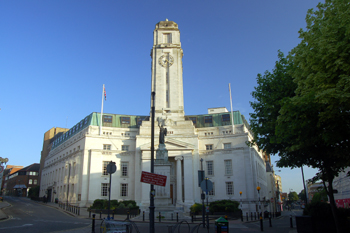
The Town Hall June 2010
Luton is an ancient parish in the Flitt Hundred. It comprised the hamlets of East Hyde, West Hyde, Leagrave, Limbury and Biscot and Stopsley. The parish church of the ancient parish was Saint Mary's. During the 19th century the notion of two types of parish arose. The ecclesiastical parish remained the unit of governance for the Church of England but for local government functions the civil parish came to be used, and this might have very different boundaries to the ecclesiastical parish.
In 1894 Luton was divided into two short lived civil parishes, Luton Urban and Luton Rural. The latter was abolished just two years later and partly absorbed into Luton Urban which was then simply renamed the civil parish of Luton. Also in 1896 three new civil parishes were formed from Luton Rural: Leagrave, Limbury and Stopsley.
Leagrave civil parish was abolished in 1928 and divided between Luton, Houghton Regis and Sundon. Limbury was abolished in the same year and divided between Luton, Streatley, Sundon and Stopsley. Then, in 1933 Stopsley was abolished and divided between Luton, Hyde and Streatley.
The ecclesiastical parishes of Biscot, Leagrave, Limbury and Stopsley were created in 1866, 1954, 1971 and 1861. They survive up to the time of writing [2010].
The hamlets of East Hyde and West Hyde had formed part of the ancient parish of Luton. A separate ecclesiastical parish of East Hyde, embracing both, was created in 1859. A civil parish, called, simply, Hyde was created in 1896 from part of Luton Rural and is the only one of the four civil parishes created at that time to survive and today [2010] forms part of the unitary authority of Central Bedfordshire rather than Luton Borough.
Luton became a municipal borough in 1876. This meant that it acquired functions of local government which were much broader than those of a simple civil parish including public health, planning and transport. The first mayor was William Bigg, bank manager of the London County Bank. The borough area was successively widened in 1895, 1925, 1933, 1939 and 1964 to allow for a growing population.
In 1964 Luton became a County Borough giving it additional powers which, since 1889, had been exercised by Bedfordshire County Council. With the reorganisation in local government of 1974 these powers were stripped away and Luton resumed being a simple borough exercising second tier functions under Bedfordshire County Council. Interestingly, there had been a proposal to combine Luton with Watford in Hertfordshire as a new first tier authority.
Luton then had to wait just over twenty years, but in 1997 regained all its first tier powers, breaking away from Bedfordshire County Council to become a unitary authority. The town remained part of Bedfordshire for ceremonial purposes as it still does, despite the abolition of the county in 2009 as the county council was replaced by two other unitary authorities, Bedford Borough and central Bedfordshire.